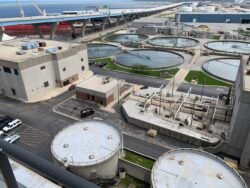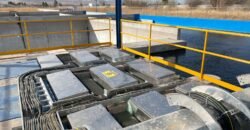Columbia Wastewater Treatment Plant
The vitality of any city lies beneath the surface—where infrastructure and engineering play a pivotal role in sustaining urban life’s delicate equilibrium. The Columbia Wastewater Treatment Plant, a cornerstone for the city of Columbia, exemplifies this hidden marvel. Stretching over decades of evolution, from rudimentary sanitation efforts to advanced treatment methodologies, this plant stands as a testament to modern engineering, environmental stewardship, and community-oriented innovation.
Historical Background and Evolution
Early Beginnings
Originally founded in the early 20th century, Columbia’s efforts to manage wastewater were rudimentary. Utilizing basic diversion channels and rudimentary sedimentation tanks, the goal was simply to divert raw sewage from residential areas to natural water bodies. During this period, public health crises like cholera outbreaks were common, underscoring the urgent need for more effective wastewater management solutions.
The Era of Modernization
The mid-20th century witnessed significant shifts in wastewater treatment methodologies. With increasing urbanization and heightened awareness regarding waterborne diseases and environmental impact, the City of Columbia embarked on an ambitious journey to modernize its wastewater treatment infrastructure.
In the 1950s, the first significant upgrade came in the form of primary treatment facilities designed to remove large particles and organic solids through sedimentation processes. By the 1970s, secondary treatment capabilities were integrated, incorporating biological processes to degrade dissolved and suspended organic matter effectively.
Engineering and Technical Facets
Primary Treatment
The primary treatment stage starts with screening, where coarse debris such as plastic, cloth, and other inert materials are removed. Using bar screens and grit chambers, the plant ensures that large debris does not interfere with subsequent processes. This not only protects the internal components of the facility but also ensures more efficient secondary treatment.
Secondary Treatment
Activated sludge, a cornerstone of secondary treatment, involves aeration basins where microbes break down organic matter in the wastewater. Aeration tanks facilitate this process by pumping air into the mixture, maximizing oxygen availability for microbial action. The end result is a significant reduction in biodegradable organic matter, transforming it into carbon dioxide, water, and microbial biomass.
Tertiary Treatment
With increasing regulatory demands and awareness about the environmental impact, the plant introduced tertiary treatment processes. These advanced methods focus on polishing the effluent water to remove any remaining contaminants. Techniques such as filtration, nutrient removal (nitrogen and phosphorus), and disinfection through chlorination or UV treatment ensure the final effluent is safe for discharge into natural water bodies or for reuse.
Innovations and Technological Integration
Membrane Bioreactors (MBR)
One of the pioneering advancements at the Columbia Wastewater Treatment Plant is the adoption of Membrane Bioreactors. By integrating membrane filtration technology with biological treatment processes, this system showcases extraordinary efficiency in separating solid materials from liquid, producing high-quality effluent with minimal footprint. MBR systems offer better sludge management, reduced footprint, and superior effluent quality, setting a new benchmark in wastewater management.
Supervisory Control and Data Acquisition (SCADA)
Modernization extended to the control systems as well. The inclusion of SCADA systems has revolutionized the monitoring and control aspects of the plant operations. SCADA allows real-time data acquisition, facilitating informed decision-making and optimizing operational efficiency. Parameters such as pH, temperature, and dissolved oxygen levels are continuously monitored, ensuring that the treatment processes remain within optimal ranges.
Energy Recovery Systems
Energy sustainability is another crucial aspect. By leveraging anaerobic digesters for sludge treatment, the plant can capture biogas, predominantly methane, which can then be used for generating electricity. This not only reduces the plant’s carbon footprint but also lowers operational costs significantly. The incorporation of Combined Heat and Power (CHP) systems has further enhanced the energy efficiency, making the plant a model of sustainable practices.
Environmental Impact and Benefits
Water Quality Improvement
Columbia’s water bodies are significantly cleaner thanks to the rigorous treatment processes employed. Nutrient-rich effluents, which once led to eutrophication and the subsequent degradation of aquatic ecosystems, are now effectively managed. The plant’s advanced nutrient removal techniques ensure that nitrogen and phosphorus levels in the discharged water are within safe limits, mitigating risks to aquatic life.
Habitat Restoration
The positive impacts extend beyond water quality. Riparian habits, crucial for maintaining biodiversity, have shown remarkable improvement. Cleaner water allows for healthier ecosystems where flora and fauna thrive—evidenced by the resurgence of fish populations and other aquatic life in local rivers and streams.
Public Health
One of the most direct benefits of efficient wastewater management is improved public health. The removal of pathogens and harmful bacteria from wastewater minimizes the risk of waterborne diseases. The plant’s stringent disinfection protocols ensure that Columbia’s residents enjoy a safer, healthier environment.
Challenges and Future Prospects
Regulatory Compliance
Regulatory landscapes are continually evolving, with standards becoming stricter to safeguard environmental and public health. Adhering to these dynamic regulations requires constant upgrades and innovations. The Columbia Wastewater Treatment Plant has successfully navigated this landscape through proactive measures and continuous investment in research and development.
Climate Change
Climate change poses another set of challenges. Increased rainfall leading to stormwater overflow can overwhelm existing treatment capacities. To address this, the plant has incorporated green infrastructure solutions such as permeable pavements, rain gardens, and expanded storage capacity for stormwater management.
Technological Integration
Future prospects are heavily anchored in further technological integration. The rise of IoT (Internet of Things) offers new opportunities for smarter wastewater management. Predictive analytics can foresee system stress points, whereas machine learning algorithms can optimize operations in real time.
Community Engagement and Education
Outreach Programs
Effective wastewater treatment isn’t just about engineering prowess; it’s also about fostering community engagement. The Columbia Wastewater Treatment Plant has initiated numerous outreach programs aimed at educating the public about the importance of wastewater treatment. School visits, workshops, and informational drives help demystify the complexities involved, making the community more appreciative of the plant’s efforts.
Public-Private Partnerships
Collaborations with educational institutions and private enterprises have paved the way for innovative solutions. Public-Private Partnerships (PPPs) facilitate funding, R&D efforts, and pilot projects, accelerating the adoption of cutting-edge technologies.
Long-Term Vision
The long-term vision for the Columbia Wastewater Treatment Plant is one of sustainable growth and resilience. Plans are underway to further reduce the plant’s carbon footprint through upgraded renewable energy solutions, such as the incorporation of solar panels and the exploration of algae-based treatment systems for nutrient recovery.
The adoption of decentralized treatment units, especially in newly urbanizing areas, is being considered to relieve pressure on the central plant. These satellite units could offer primary and secondary treatment, while the main facility focuses on advanced tertiary treatments and energy recovery.
Conclusion
The Columbia Wastewater Treatment Plant stands as an engineering marvel and environmental sentinel, playing a crucial role in the city’s infrastructure. From historical advancements to modern challenges, the plant has continually evolved, integrating cutting-edge technologies and sustainable practices.
Its multifaceted approach not only addresses the pressing demands of wastewater management but also fosters community engagement, environmental stewardship, and public health improvements. As we look to the future, the plant’s commitment to innovation and sustainability ensures that it will continue to meet the community’s needs, safeguarding both natural ecosystems and public well-being.


